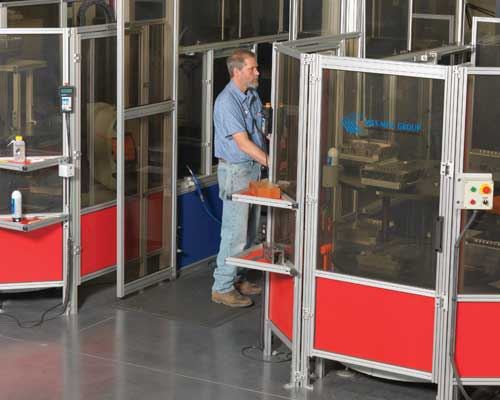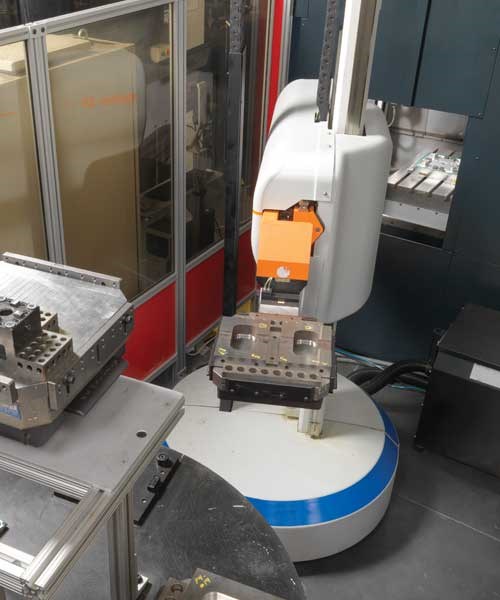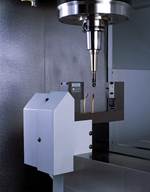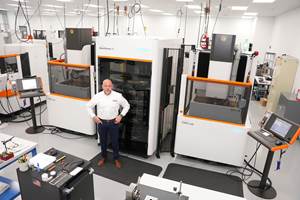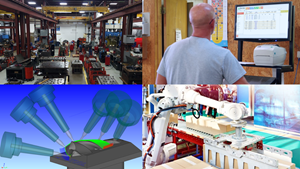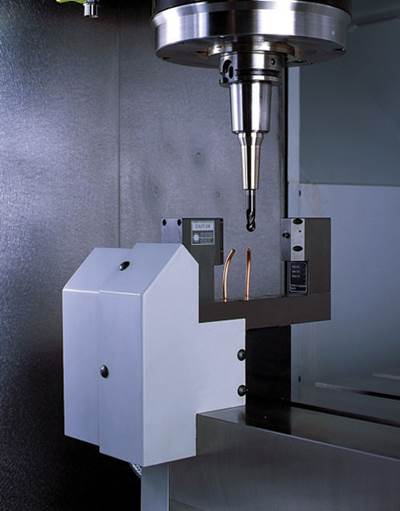Automated Hard Milling Expands Capacity, Capability
“The key to investing in new machinery is to get more work done with the same amount of people, not the same amount of work with fewer people. To accomplish this, you need automated machining capabilities that are both flexible and reliable."
Streamlining a die/mold manufacturing process can be accomplished through automation, enabling companies to increase throughput without adding real estate. However, as workpiece designs continue to grow in complexity, manufacturers must support these automated systems with accurate, repeatable and reliable machining technologies. For North American manufacturers, this combination has proven to offer a competitive advantage against many low-labor-cost countries.
“The benefits of work cells are no longer exclusive to part production environments. In fact, the influence of today’s global marketplace has made these capabilities essential to the competitiveness of North American mold manufacturers,” says Scott Matenaer, tool-room operations manager at MGS Mfg. Group (Germantown, WI). “By embracing this level of technology and focusing our efforts on the engineering and production of complex tools, we are able to offer our customers unprecedented flexibility, quality and delivery at an affordable price.”
MGS was recently ranked as one of the top 15 moldmakers in North America by Plastics News, based on tooling sales. In the last year, the company has produced and sold over 400 molds for a broad customer base, including consumer products, medical, electronics and automotive. Based on the diversity of MGS’s “one-off” production, automation systems have been a key component to the shop’s flexibility and scheduling management.
The one commonality that exists between the applications produced at MGS is the level of complexity. According to MGS, recent designs have included 64 HRc steels with required tolerances of plus or minus 0.0003 inches with repeatability within 0.0002 inches.
“In nearly all cases, designing and building the style of production molds that move through this facility involves a great deal of development and prototyping—engineering the part for manufacture,” says Matenaer. “To accomplish this in a lights-out environment requires access to reliable, accurate and efficient machining technologies.
“When faced with hard milling limitations in 2011, we decided to update our machining technologies with investments in two Makino V33i vertical machining centers,” Matenaer continues. “The investment has proven to be a sound business decision that has enabled us to get the most out of our automated work cells, improving workflow and adding new capabilities to build on our history of innovation.”
Up for a Challenge
Founded in 1982 by CEO Mark G. Sellers, who happened to be a state of Wisconsin journeyman toolmaker, MGS began its operations as an injection-mold tool shop. While molding operations now make up over 60 percent of the company’s revenue, its ability to successfully engineer, design and build plastic injection molds remains the foundation.
MGS believes that an injection mold is more than simply one of the required components of part manufacturing. It is an investment in productivity. The company strives to work with customers that put a premium on the productivity, efficiency and longevity of their molds. While MGS evaluates and quotes every tooling opportunity using standard factors (i.e., lead-time commitment, workpiece size, budgets, etc.), it pays particular attention to more challenging applications, such as higher cavitations, multi-shot, thin wall, living hinge, stack systems, rotary stack and spindle systems, that enable the tool shop to demonstrate its true capabilities.
Engineers at MGS understand the impact that technology has in overcoming challenges, and they have high expectations for time-sensitive delivery of consistent and repeatable workpieces. In the case of automation, the company bases its investments on output per square foot of floor space, output per employee and output per machine.
“We first began implementing automated capabilities in 2000, starting with simple pairing of individual machines with robots, which we knew would improve productivity simply by reducing downtimes incurred by manual setups and tear-downs,” notes Matenaer. “In the following years, we applied simple work cells into several different process environments, which ultimately led us to build more complex automated systems that combine various machine processes into a single cell.”
MGS applied this experience to its recent V33i investments, which have been integrated into two robot-tended work cells that share a common coordinate measurement machine (CMM). MGS attests that the speed, accuracy and consistency afforded by this configuration have dramatically enhanced prove-out processes and overall workflow of its precision hard milling applications.
“The key to investing in new machinery is to get more work done with the same amount of people, not the same amount of work with fewer people. To accomplish this, you need automated machining capabilities that are both flexible and reliable,” says Jeff Kolbow, COO of MGS. “Our goal in hard milling applications is to maximize our spindle time. The performance and reliability of the V33i machines have enabled us to routinely exceed this goal with up to 20 hours of operation per day in certain applications.”
Reliable Hard Milling Solutions
The V33i investments were a natural next step for MGS, following more than a decade of experience with Makino (Mason, OH) milling and EDM equipment. In 2001, the company invested in a Makino SNC64 vertical machining center, which has been deployed as both a graphite and hard milling machine. With approximately 50,000 hours of machine time logged, the SNC64 remains a workhorse for one of the tool shop’s neighboring MGS facilities.
In 2009, the company scoured the market for high-precision graphite machining solutions that could meet increasing demands for accuracy and repeatability. Among the potential investments identified was the V33i graphite machining center.
“When our toolmakers recognize a need for new equipment, we organize a group together to determine exact needs, such as size, horsepower, accuracy and spindle speed, in order to narrow down a list of equipment to evaluate,” states Matenaer. “In our recent graphite machining selection, we designed five test pieces featuring geometries common to our EDM applications. Results were judged on speed, accuracy and repeatability. The V33i graphite machine was one of the only technologies to meet and exceed our expectations across all criteria, producing accuracies as precise as 0.0001 inches.”
Based on these experiences, MGS was quick to identify the V33i as a potential investment for its precision hard milling applications. This addition would also enable the company to combine its graphite and hard milling operators based on their familiarity with the control system. In addition, the predominant use of automation had further increased the company’s needs for machine reliability and serviceability.
“While any machine process can benefit from automation, work cells as a whole are only as efficient and reliable as their individual components will allow,” says Kolbow. “We’ve been troubled in the past by machines with high maintenance costs and frequent inaccuracies that have dramatically increased our total investment costs. Comparatively, maintenance upkeep on our V33i investments has been among the best on our shop floor. The end result is a highly accurate, repeatable and cost-effective solution.”
Accurate, Repeatable Hard Milling
According to MGS, the accuracy and reliability of a machine is not just important to meeting specifications but also in maintaining consistent workflow.
Due to the volume and variety of workpieces, the company must operate under a tight timeline that cannot afford recutting of workpieces. All jobs are scheduled and stacked up, waiting to be loaded into the hard milling work cells. If one job is delayed, four other jobs must be expedited in order to maintain deadlines. In the worst-case scenario, this could mean a cut in profit margins as a result of outsourcing.
“There are a lot of machines available on the market that can produce the tolerances we require, but few with the level of repeatability to feel confident running them fully unattended overnight,” comments Don Rafko, toolmaker at MGS. “In our razor-blade molds, we’re expected to machine five identical seats that hold each blade at a precise pitch and distance. These have to be repeated anywhere from 24 to 64 times, oftentimes in multi-shot molds with zero tolerance. On many machine platforms, this would be a concern for us, but not the V33i.”
Rafko attests that no matter what level of accuracy a machine can provide, the overall performance can only be as good as the cutters allow. The company addresses these considerations in its hard milling work cells by incorporating laser-tool-monitoring systems that interface with the machine controls to check and verify tool diameters, dimensions and sizes. By ensuring consistency among tooling, MGS is repeatedly achieving tolerances within plus or minus 0.0003 inches.
A secondary benefit that MGS has experienced as a result of its newfound hard milling accuracy is the ability to reduce or eliminate EDM operations. This capability has enabled the company to trim lead-times while removing manual handwork and improving the surface integrity of its molds.
“We’ve been slowly reducing EDM processes over the last decade due to higher spindle speeds and better tooling options,” says Matenaer. “In some cases our hard milling machines are now producing better quality, consistency and accuracy straight out of the machine than what can be accomplished through EDM processes.
“Our ability to substitute hard milling in place of EDM processes has influenced the way that we design blocks, cavities and cores,” Matenaer continues. “Corner radii that once would have remained sharp for EDM processing are now designed into the milling process. Parting lines are cut directly in the mill, which not only saves us time, but graphite production and expenses as well. And while there are still features that require EDM processing, it remains our goal to continue eliminating as much EDM time as possible.”
Expanding Opportunities
According to the engineering team at MGS, current applications are only scratching the surface of what they can potentially accomplish within precision hard milling. The company anticipates that further optimization of these technologies is likely to enable MGS to expand into more complex markets, such as micromachining.
“As a North American mold manufacturer, you must continually seek out new challenges and opportunities to remain competitive,” says Kolbow. “This is why proper machining investments are critical to the expansion of your business. It’s not enough to just replace equipment. Technology has to add capabilities and remain a catalyst for engineering leadership.
“Streamlining and improving our hard milling processes has enabled us to simplify the complex. We put raw materials into the cell, and finished parts come out,” Kolbow adds. “There’s no rework, and labor time is dramatically less than what is required by EDM processes. We can spend more time and energy focusing on the engineering of complex applications while simultaneously improving cycle times, workpiece quality, unattended capabilities and overall cost per part.”
For More Information
MGS Mfg. Group / (262) 255-5790
mgstech.com
Related Content
Mold Builder Meets Increased Domestic Demand With Automated Cells
Burteck LLC experienced significant demand increases due to reshoring and invested in automated machining cells to step up its production output quickly and avoid losing business.
Read MoreFive-Axis Graphite Mill With Automation Debottlenecks Electrode Machining
Five-axis electrode cutting enabled Preferred Tool to EDM complex internal screw geometry on an insert that otherwise would have had to be outsourced.
Read More2024 Moldmaking Insights: A Year in Review Part 1
A look back at the top moldmaking trends of 2024, as revealed through MMT's analytics. This review highlights the most popular technical articles, case studies, tips and best practices that captured the industry's attention over the past year.
Read MoreTool Paths, ERP & Improving Efficiency in Your Toolroom: What Did You Miss in February?
We covered a variety of topics in February. From tool paths to ERP and PTXPO coverage, we hope you didn’t miss anything but here is your cheat sheet if you did.
Read MoreRead Next
Simple Considerations for Automated Mold Machining
A streamlined approach to your mold manufacturing process is accomplished most effectively through machine automation.
Read MoreHow to Use Continuing Education to Remain Competitive in Moldmaking
Continued training helps moldmakers make tooling decisions and properly use the latest cutting tool to efficiently machine high-quality molds.
Read MoreHow to Use Strategic Planning Tools, Data to Manage the Human Side of Business
Q&A with Marion Wells, MMT EAB member and founder of Human Asset Management.
Read More
